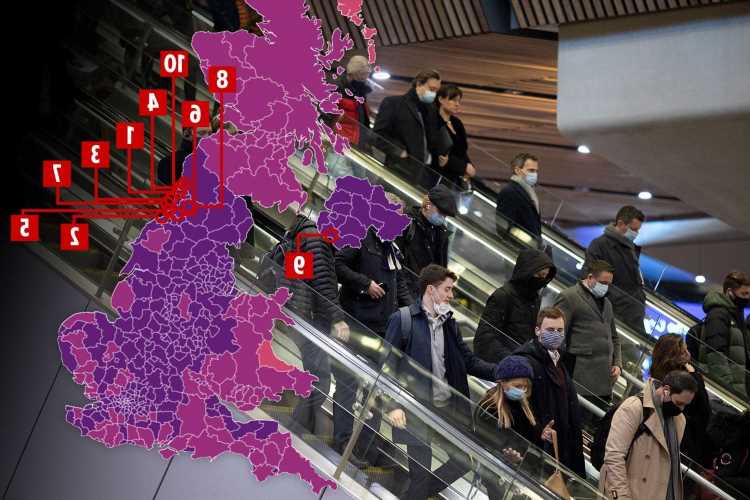THE epicentre of coronavirus infections has shifted in the UK as cases continue to fall across the country, data has revealed.
All 377 local authority areas have seen a fall in infections in the last week and the interactive map below shows how your local area fares.
It was yesterday reported that Covid infections were down 22 per cent on last week and the Prime Minister is today poised to announce the end of some Plan B restrictions.
A cluster of infections has been detected in the North East of England, which also currently has the highest R rate in the country, sitting between 1.4 and 1.7 with the English average between 1.1-1.5.
Areas in Northern Ireland had previously made up the most infected areas, but that has now shifted to the North East.
The top three most infected areas in the country are all in the North East and the region also makes up the majority of the top ten infected places in the country.
South Tyneside has the highest rate in the UK, with 2,526 new cases in the seven days to January 14 – the equivalent of 1,671.4 per 100,000 people.
This is down from a rate of 2,738.6 for the seven days to January 7.
Most read in Health
TIME TO BO? D-day for Boris as he faces fiery PMQs and is knifed by own furious MPs
UK Covid cases down 21% on last week as Javid hints Plan B ‘reduced in days’
The 4 ways to relieve trapped wind and beat the bloat fast
Nurse, 31, reveals little-known 'torturous' Covid side effect
Middlesbrough has the second highest rate, down from 3,196.4 to 1,660.5, with 2,346 new cases.
Sunderland has the third highest rate, down from 2,750.8 to 1,639.8, with 4,556 new cases.
🔵 Follow our Covid live blog for all the latest updates
Newry, Mourne & Down has the highest rate in Northern Ireland (1,431.7, down from 2,557.4).
While South Lanarkshire has the highest rate in Scotland (720.0, down from 2,135.5); and Neath Port Talbot has the highest rate in Wales (659.3, down from 2,007.8).
The fall in all 377 areas comes as Prime Minister Boris Johnson could today announce that remaining coronavirus restrictions could be scrapped in a matter of days.
Orders such as the working from home rule and vaccine passports could come to an end, while the compulsory use of masks is likely to remain in place.
The PM hopes the move will buy him some much-needed support among his backbenchers.
Boris Johnson said: "We’ve got to be careful about Covid. We’ve got to continue to remember that it’s a threat."
While infections have fallen cases still remain at high levels, with Omicron being the dominant strain across the country.
But the majority of people infected with the bug say they suffer mild, cold-like symptoms.
A string of hugely positive studies show Omicron is milder than other strains in the vaccinated, with the first official UK report revealing the risk of hospitalisation is 50 to 70 per cent lower than with Delta.
Covid booster jabs protect against Omicron and offer the best chance to get through the pandemic, health officials have repeatedly said.
The Sun's Jabs Army campaign is helping get the vital extra vaccines in Brits' arms to ward off the need for any new restrictions.
REGIONAL BREAKDOWN
Data from the government's coronavirus dashboard shows that infections are currently below 14,000 a day in all regions.
The most recent data shows that in the South East, 13,739 people a day are testing positive, this is down from 12,679 people on January 13.
In London, 11,116 people are currently testing positive, down from 12,491.
It's important to remember that infections in London and areas such as the south East may be higher than other due to the size of the region.
In the North West daily infections are down from 11,786 to 10,177 and in the East of England, infections are up from 8,815 to 9,381.
The West Midlands has seen a fall, going from 11,049 to 10,102.
Yorkshire and the Humber has seen a fall from January 13, going from 9,679 a day to 9,147 a day.
In the South West, daily infections have increased from 6,646 to 7,646 and in the East Midlands, there has been a drop from 7,055 to 6,990.
While the North East has the majority of most infected areas, daily infections have also dropped slightly from 5,907 to 5,809.
RULE CHANGE
As daily infections continue to drop, isolation rules for people who catch the bug were amended yesterday.
People in England who test positive for the virus can now leave isolation after five full days after daily cases more than halved in a fortnight.
The rule change was confirmed by the Health Secretary last week – after experts had called for isolation to be slashed while the NHS struggles with mass staff absences.
Fresh research suggested slashing isolation to five days would only result in an extra two in 100 people leaving quarantine while still infectious.
Key UK Health Security Agency modelling probed the risk of a positive case spreading the virus after two negative lateral flow tests.
It found eight per cent would still be infectious on day five, compared to 6.2 per cent on day seven – which led ministers to change their minds.
Source: Read Full Article





